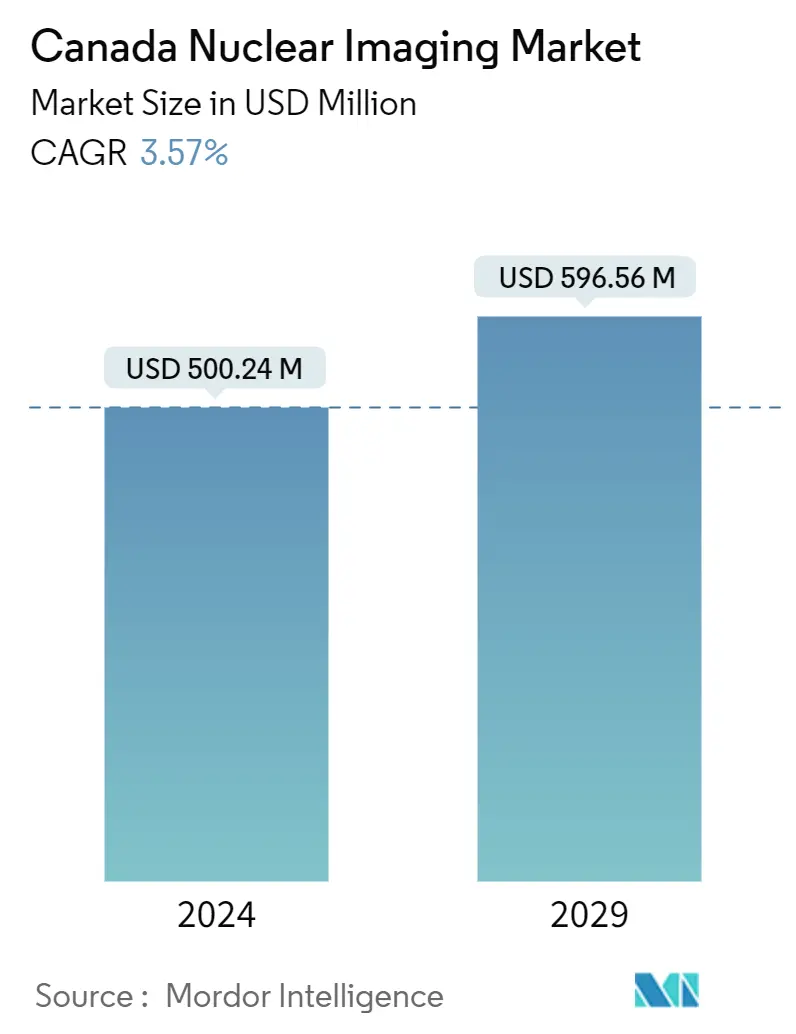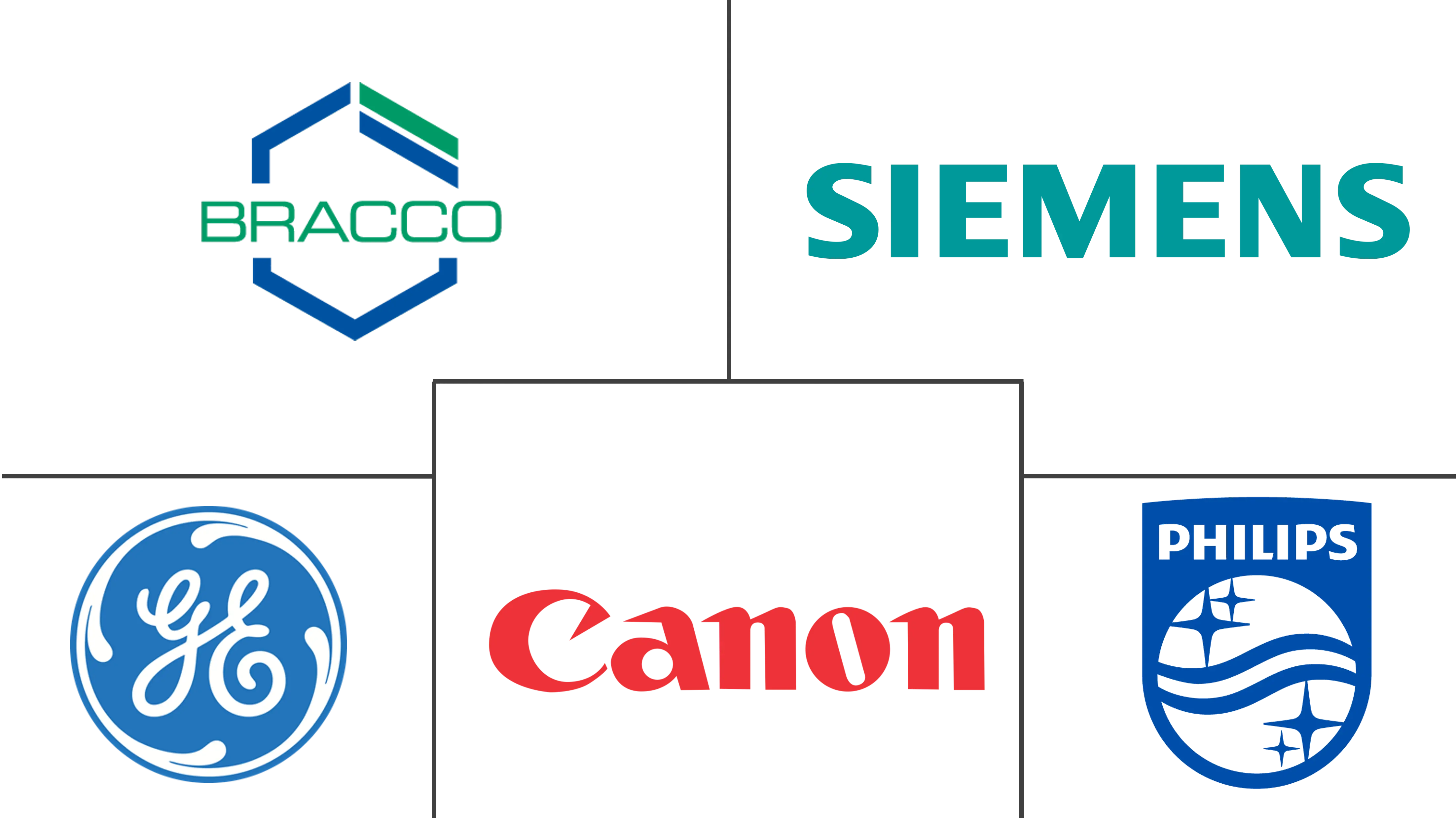Market Size of Canada Nuclear Imaging Industry

| Study Period | 2021 - 2029 |
| Base Year For Estimation | 2023 |
| Forecast Data Period | 2024 - 2029 |
| Market Size (2024) | USD 500.24 Million |
| Market Size (2029) | USD 596.56 Million |
| CAGR (2024 - 2029) | 3.57 % |
| Market Concentration | Medium |
Major Players
*Disclaimer: Major Players sorted in no particular order |
Canada Nuclear Imaging Market Analysis
The Canada Nuclear Imaging Market size is estimated at USD 500.24 million in 2024, and is expected to reach USD 596.56 million by 2029, growing at a CAGR of 3.57% during the forecast period (2024-2029).
Factors such as the rising incidence of cancer, neurological, and cardiac disorders, coupled with technological advancements, product innovations, and various government initiatives, are driving the growth of the studied market.
Given that neurological and cardiovascular diseases are leading causes of mortality in Canada, there's an escalating demand for effective diagnostic and therapeutic tools. Nuclear medicine is stepping up to meet this demand, offering in-depth insights into cardiac and neurological health. For example, as of January 2024, the Alzheimer Society of Canada estimates that 733,040 Canadians are living with dementia. Daily, over 350 Canadians receive a dementia diagnosis, equating to more than 15 new cases each hour. Projections suggest that by 2030, this figure could be near 1 million, leading to an annual addition of 187,000 new cases, or 512 daily and 21 hourly. This indicates a potential 51% annual increase in new dementia cases by 2030. Furthermore, by 2050, the number might surpass 1.7 million. Hence, the anticipated rise in neurodegenerative disease patients is poised to be a primary driver of market growth during the forecast period.
In addition, major industry players are actively pursuing strategic moves to bolster their market presence. These maneuvers encompass mergers, acquisitions, collaborations, partnerships, and product unveilings. For instance, in November 2023, the QEII Foundation clinched a USD 3 million deal to procure two state-of-the-art StarGuide Hybrid SPECT/CT scanners. This acquisition positions QEII at the forefront of nuclear medicine, marking it as the inaugural Canadian hospital to embrace this technology. Such a strategic move is poised to enhance its outreach and is expected to catalyze market growth.
Furthermore, the uptick in cyclotron launches for alpha-emitting radioisotopes is set to broaden the spectrum of radioisotope availability in nuclear medicine. For instance, in May 2023, Advanced Cyclotron Systems Inc. unveiled its TR-ALPHA cyclotron tailored for alpha-emitting radioisotopes. This innovation empowers healthcare facilities and research entities with a dedicated cyclotron, amplifying the production of alpha-emitting radioisotopes for cancer treatment, thereby bolstering market growth.
Additionally, the intensified focus of market players on developing and producing radioisotopes for targeted alpha therapies (TATs) is propelling the market forward. For instance, in October 2023, Canadian Nuclear Laboratories (CNL) and ITM Isotope Technologies Munich SE (ITM) inaugurated a joint venture named Actineer, aimed at advancing Actinium-225 technologies. This collaboration is centered on establishing a new production facility in Canada, dedicated to generating industrial-scale quantities of rare medical isotopes pivotal for nuclear medicine.
Given the significant cancer burden and proactive industry strategies, the market is poised for growth in the coming years. Yet, challenges loom with the ongoing radioisotope shortages and stringent Canadian regulations, which could temper this growth trajectory.
Canada Nuclear Imaging Industry Segmentation
Nuclear medicine imaging procedures are non-invasive, with the exception of intravenous injections, and are usually painless medical tests that help physicians diagnose and evaluate medical conditions. These imaging scans use radioactive materials called radiopharmaceuticals or radiotracers. These radiopharmaceuticals are used in diagnosis and therapeutics. They are small substances that contain a radioactive substance used in the treatment of cancer and cardiac and neurological disorders.
Canada's nuclear imaging market is segmented by product and application. based on product the market is segmented as equipment and diagnostic radioisotope. Based on application the market is segmented as an application SPECT application and PET application. The report offers the value (in USD) for the above segments.
| By Product | ||||
| Equipment | ||||
|
| By Application | ||||||
| ||||||
|
Canada Nuclear Imaging Market Size Summary
The Canada nuclear imaging market is poised for steady growth over the forecast period, driven by the increasing prevalence of cancer and cardiac disorders, alongside technological advancements and product development. The market experienced a moderate impact during the COVID-19 pandemic, with nuclear imaging proving essential in diagnosing the disease, thereby boosting the demand for PET and SPECT units. Despite challenges such as long wait times and the shortage of radioisotopes, strategic initiatives by major players, including collaborations and investments in new facilities, are expected to enhance market capacity and capabilities. The adoption of new procedure guidelines and regulatory approvals further supports the market's expansion, particularly in the application of nuclear imaging for neurological disorders.
The demand for nuclear imaging, especially SPECT, is significantly influenced by the rising incidence of neurological disorders in Canada, such as dementia and Parkinson's disease. The high burden of these conditions, coupled with the approval of new imaging technologies and procedures, is anticipated to drive segment growth. The market is characterized by a few dominant players, with companies like Bracco Imaging SpA, GE Healthcare, and Siemens Healthineers holding substantial market shares. Recent collaborations and investments in advanced imaging equipment underscore the competitive landscape, as stakeholders aim to enhance diagnostic capabilities and develop innovative radiopharmaceuticals. These developments are expected to contribute to the market's growth trajectory, addressing the increasing demand for precise and efficient nuclear imaging solutions.
Canada Nuclear Imaging Market Size - Table of Contents
-
1. MARKET DYNAMICS
-
1.1 Market Overview
-
1.2 Market Drivers
-
1.2.1 Increasing Prevalence of Cancer, Neurological Diseases and Cardiac Disorders
-
1.2.2 Technological Advancements in Nuclear Imaging
-
-
1.3 Market Restraints
-
1.3.1 Shortage of Radioisotopes and Stringent Regulations
-
-
1.4 Porter's Five Forces Analysis
-
1.4.1 Threat of New Entrants
-
1.4.2 Bargaining Power of Buyers/Consumers
-
1.4.3 Bargaining Power of Suppliers
-
1.4.4 Threat of Substitute Products
-
1.4.5 Intensity of Competitive Rivalry
-
-
-
2. MARKET SEGMENTATION (Market Size by Value - USD)
-
2.1 By Product
-
2.1.1 Equipment
-
2.1.2 Diagnostic Radioisotope
-
2.1.2.1 SPECT Radioisotopes
-
2.1.2.2 PET Radioisotopes
-
-
-
2.2 By Application
-
2.2.1 SPECT Applications
-
2.2.1.1 Cardiology
-
2.2.1.2 Neurology
-
2.2.1.3 Thyroid
-
2.2.1.4 Other SPECT Applications
-
-
2.2.2 PET Applications
-
2.2.2.1 Oncology
-
2.2.2.2 Cardiology
-
2.2.2.3 Neurology
-
2.2.2.4 Other PET Applications
-
-
-
Canada Nuclear Imaging Market Size FAQs
How big is the Canada Nuclear Imaging Market?
The Canada Nuclear Imaging Market size is expected to reach USD 500.24 million in 2024 and grow at a CAGR of 3.57% to reach USD 596.56 million by 2029.
What is the current Canada Nuclear Imaging Market size?
In 2024, the Canada Nuclear Imaging Market size is expected to reach USD 500.24 million.

